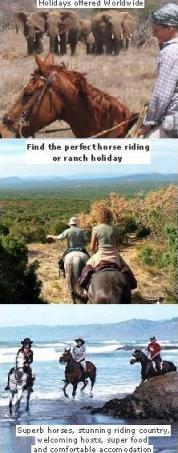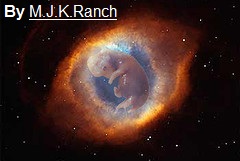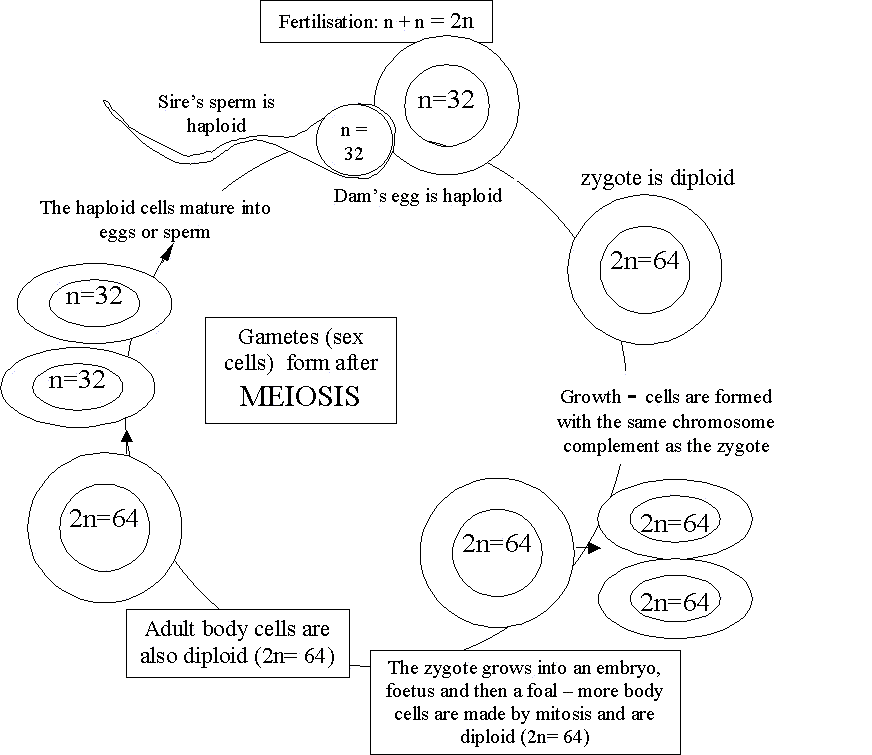inheritance and horse reproduction




|
This page deals with horse reproduction in a genetic sense, rather than from the point of view of horse breeding practicalities. Readers wanting information on more practical aspects of horse breeding can click here (UK) or here (USA) or here (Canada) for books on horse breeding and reproduction. There is just enough here about the process of meiosis and fertilisation to understand how genes are inherited during horse reproduction, plus a little on how these genes are then passed on to the cells of the body.
During reproduction the dam donates an egg and the sire donates sperm to each of its progeny. A single sperm fuses with the egg to produce a fertilised egg – called a zygote (in the case of non-identical twins the dam produces two eggs, each of which is fertilised by a single sperm).
The eggs and sperm can be thought of as the vehicles of heredity: they carry the genes that determine the similarity of the offspring to their parents, and the heritable differences between offspring. It is during their formation in the male and female reproductive organs that the processes that give rise to heredity and variation occur.
If all body cells inherit the same genetic information we might ask why they aren’t all identical to one another. In general the reason is to do with the way in which the different parts of the genetic information are used (or not used) in different cells. The sex organs will develop from somatic cells, and within these the next generation of sperms or eggs will form.
The genetic part of horse reproduction that gives rise to eggs and sperm is called meiosis. It causes the division of a body cell into two gametic cells (the general name for eggs and sperm cells and their precursors). Each gametic cell has only one copy of each chromosome present in the body cells. Such cells are said to be haploid, compared with somatic cells which are diploid. The haploid number is denoted n, the diploid 2n. In horses n=32 and 2n=64. When two haploid gametes are fused at fertilisation, the diploid number of chromosomes is restored in the zygote. The alternation of meiosis and fertilisation in the life cycle maintains the constancy of the chromosome complement from one generation to the next (see figure 1).
Meiosis provides for heredity by distributing a complete haploid set of chromosomes into each of the gametes. The gametes in turn transmit their chromosome sets to the zygotes formed at fertilisation. In this way genes are handed on from parents to their offspring during horse reproduction.
Meiosis allows for variation since different gametes have different combinations of parental chromosomes. The diploid cells which undergo meiosis have two sets of chromosomes - one set from each parent, which we can call the maternal and paternal sets. Although each set carries a full quota of genetic information, the genes which specify individual character differences may be present as different alleles. So, for example, the gene which determines whether a horse will be gray occurs in two forms, alleles which are symbolised as G+ and GG. Each horse has two copies of the gray gene, one from each parent, and may therefore have genotype G+G+, G+GG or GGGG for this particular gene. Each egg or sperm has only one copy of the gray gene, which may be of allele G+ or GG.
Apart from the segregation of individual chromosomes during horse reproduction there is a second way in which variation is created. During the process of meiosis, the paternal and maternal chromosomes of each pair come together and may exchange parts with one another. For obvious reasons this process of genetic exchange is called crossing over.
Crossing over occurs in such a precise way that the recombined chromosomes neither lose or gain information. They simply carry new combinations of the different alleles that were present in the maternal and paternal chromosome partners (i.e. alleles are swapped). So the maternal chromosomes will carry some alleles originally present in the paternal chromosomes and vice-versa, creating new combinations not present in the body cells of the parents. This causes extra variation in foals compared with the parents. You can learn more about crossing over at the partial linkage section of the basic genetics page.
We can now see that meiosis and fertilisation ensure that horse reproduction results in foals with some characters of each parent, but with variation between siblings (brothers and sisters).
horse breeding and genetics books - UK
|

|






 If all goes well a new individual will develop from the zygote. The division from the single-celled zygote leads to the production of all the cells that make up the body. These body cells are called somatic cells and are the units of structure and function that comprise all living organisms. Each somatic cell inherits a copy of the genetic material present in the zygote.
If all goes well a new individual will develop from the zygote. The division from the single-celled zygote leads to the production of all the cells that make up the body. These body cells are called somatic cells and are the units of structure and function that comprise all living organisms. Each somatic cell inherits a copy of the genetic material present in the zygote.

